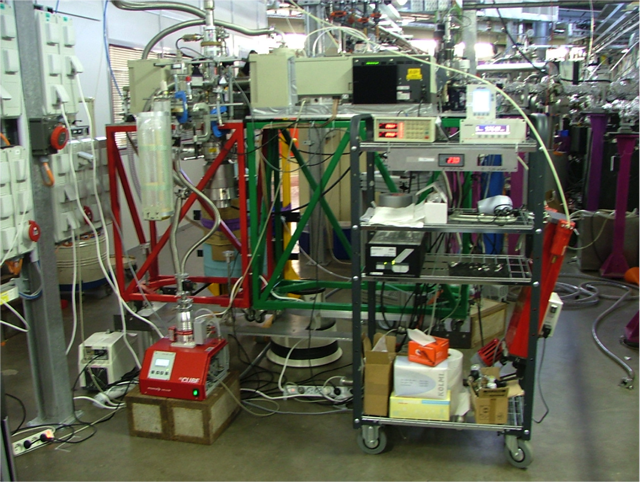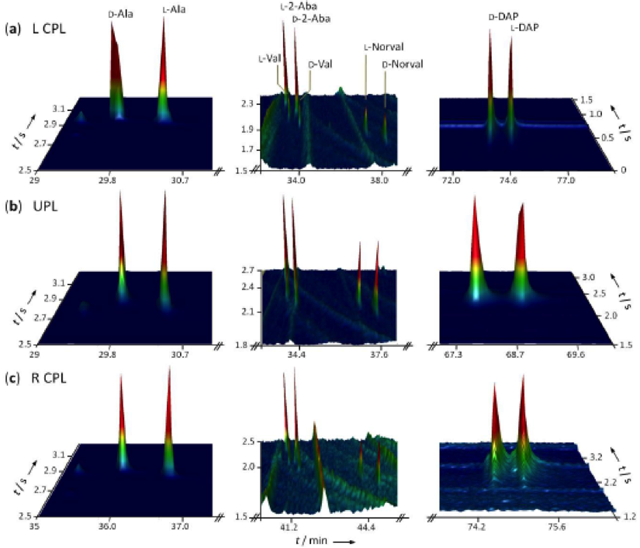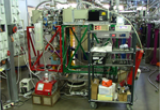Chiral-MICMOC: the origin of asymmetry of biological molecules on the Earth?
Since 2003, the team “Astrochimie et Origines” at IAS has developed an experimental apparatus to reproduce certain characteristics of the evolution of interstellar/pre-cometary ices that are widely observed in the spectra of dense molecular clouds out of which stars, disks, planets and various debris such as comets and asteroids do form. Most of the work concentrates on the photochemical evolution of these ices that lead to some soluble complex organic material that may present some analogy with materials found in meteorites. This experiment, known under the name MICMOC, does indeed produce, in the form of an organic residue, many molecules such as amino acids that may be significant for the starting of prebiotic chemistry at the surface of telluric planets. A slight modification of this experiment, named Chiral-MICMOC, is performed on the synchrotron SOLEIL facility, using the beamline DESIRS. This beamline provides circularly polarized light in the UV range (UV-CPL) that is connected to the MICMOC apparatus (see Figure 1). The goal of this experiment is to measure a transfer of the asymmetry of the light (the chiral photons) to the produced organic matter and in particular to the amino acids produced by the photochemistry. The performance of DESIRS is unique in the world and ensures a photon fluence at different wavelengths of UV-CPL, thanks to the work of Laurent Nahon, the beamline manager, and co-worker on this experiments. Samples are extracted from their supporting window at room temperature, carefully kept under argon to avoid oxidation and sent to our collaborators in Nice, Uwe Meierhenrich and Cornelia Meinert (ICN, Nice) to be analyzed by multidimensional gas chromatography techniques (GCxGC-TOF MS). To avoid any possible contamination during handling, laboratory samples are labelled with 13C so that enantiomeric excesses (e.e’s) are performed only on amino acids containing 13C. New results have recently been achieved on five different amino acids to generalize results previously obtained on only one (alanine) in 2011.
Enantiomeric excesses of the same sign have been obtained on 5 amino acids (see Figure 2): α-alanine, valine (proteinogenic ones); 2,3-diaminopropionic acid, 2-aminobutyric acid, and norvaline (non-proteinogenic). The measured excesses are always quite small (2% max) but comparable to some observed in a few carbonaceous primitive meteorites. These results allow reinforcing an astrophysical scenario leading to a possible source of asymmetry that is necessary in prebiotic chemistry to further lead to homochirality by a still unknown process. The fact that these five amino acids show the same behavior (excess of the same sign with the same helicity of the irradiating UV-CPL) is absolutely necessary for the astrophysical scenario to be considered. Photochemistry of achiral ices does lead to chiral molecules but, in the presence of UV-CPL, the amino acids detected do show some enantioselective effect leading to small excesses (of L or D enantiomer, depending on the helicity of the light).
For alanine, more experiments have been performed in which the helicity of the UV-CPL and the used energy of the chiral photons (6.6 and 10.2 eV) have been changed. A direct connection has been observed between the helicity of the light (left or right polarization) and the sign of the measured excesses, suggesting an effect of circular dichroism. Moreover, enantiomeric excesses of the same sign have been obtained when irradiating ice analogues only (at 78 K) or organic residues only (at room temperature). This result clearly shows the formation of chiral entities within the initially achiral ices as well as the possibility to transfer the asymmetry to the organic residue itself. These organic residues could thus be present in grains at late stages of the molecular cloud and then accumulating in planetesimals and various debris (comets, asteroids) before their delivery to planets (such as the Earth).
High degrees of CPL (up to 22% in the infrared domain) have been observed in regions of high mass star formation such as the Orion Nebula and NGC 6334. The spatial extension of the same helicity of the observed CPL is much larger (a factor 100) than the size of the Solar System which allows the possibility to keep excesses of one sign only in chiral organic molecules (L in the case of amino acids in our Solar System) and may explain excesses observed in meteorites.
This experiment of laboratory astrophysics may thus help to validate a very old hypothesis in which the enantio-selectivity in biological molecules, first discussed by Pasteur in 1848, is the result of a fully deterministic pathway, later discussed by Pierre Curie in 1897 and involving the action of asymmetric (or chiral) photons.
Indirect implications of this result may be that the solar nebula was indeed formed in a region of massive stars. This idea was suggested thirty years ago to account for the observation of the presence of extinct radionuclides in primitive meteorites as a consequence of the supernovae considered to be responsible for the collapse of the molecular cloud from which the Sun was formed.
This experiment is now investigating the behavior of other molecules of relevance for prebiotic chemistry such as sugars, recalling that biological sugars have an homochirality of the D sign (opposite to the amino acids). This peculiarity may also be approached by the chiral-MICMOC experiment in the near future.
Modica, P. et al, ApJ 788, 79 (2014)
For more information: Louis Le Sergeant d’Hendecourt ldh @ ias.u-psud.fr

Figure 1 : Figure 1: the experimental set-up from IAS on the DESIRS beamline at SOLEIL

Figure 2: multi-dimensional gas chromatograms of the five amino acids




